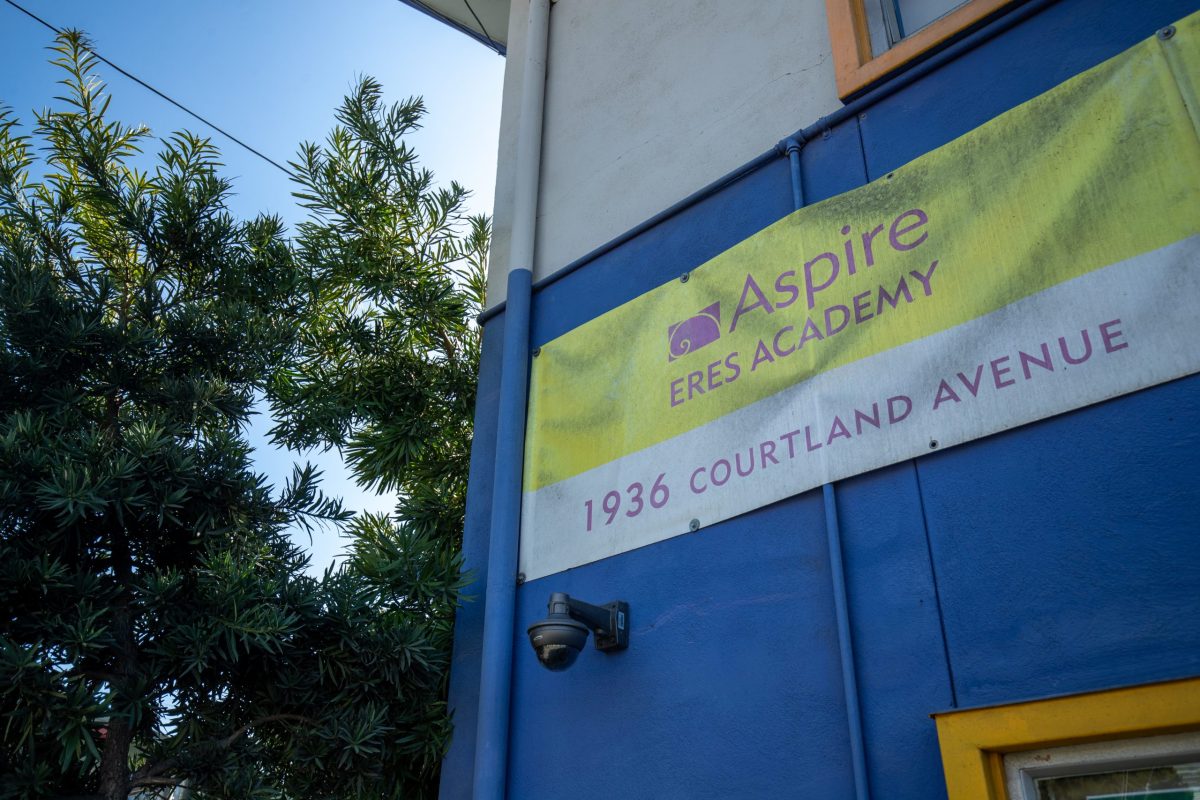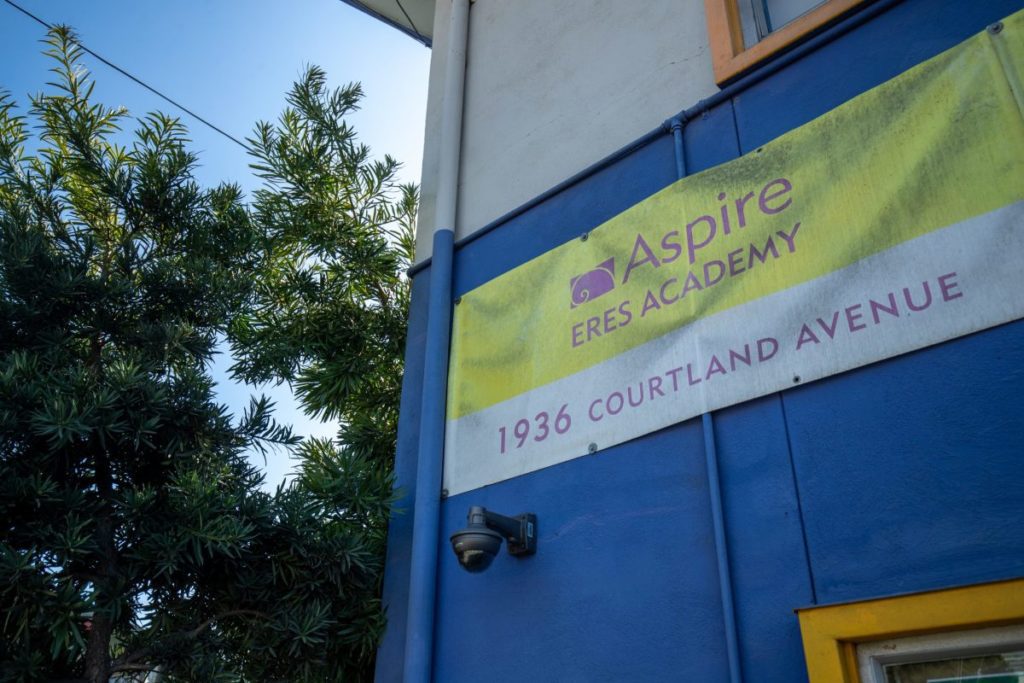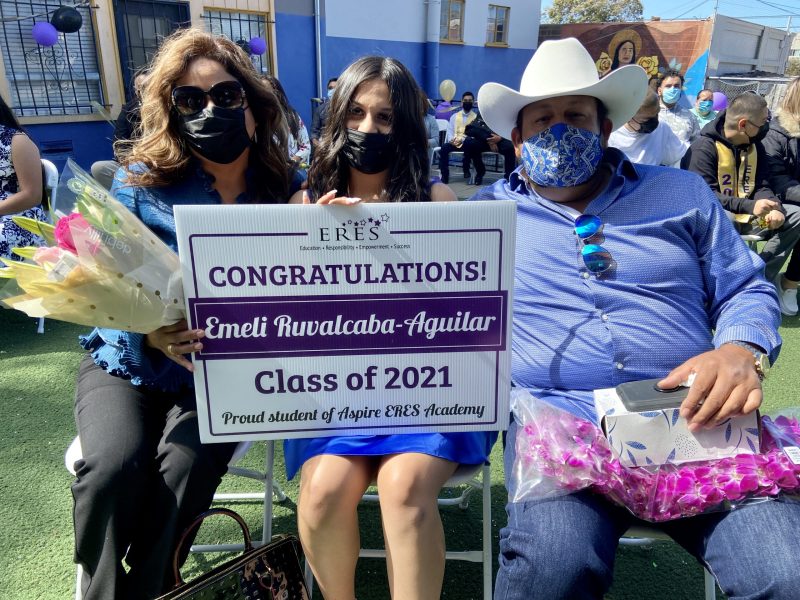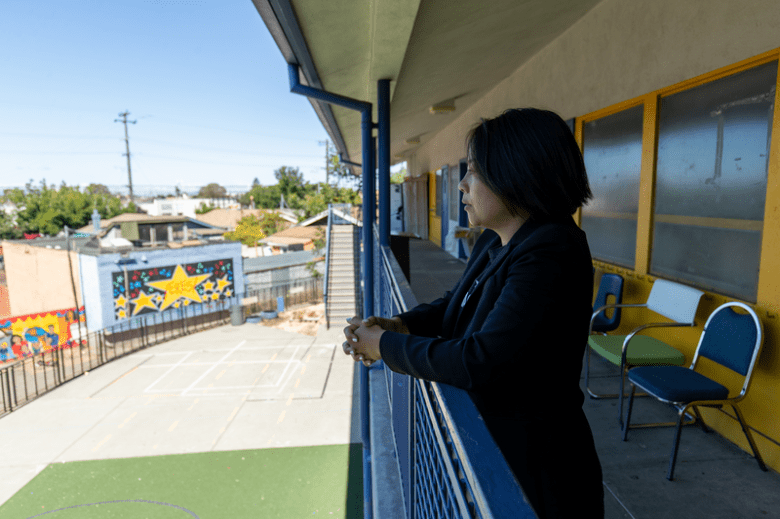
Aspire ERES students, staff say goodbye to their shuttered Fruitvale charter school
Unable to find a permanent location to allow for expansion, the school became financially unsustainable and is closing this year.
Original article found here.

by
Friday was the last day of school for the 226 students enrolled at Aspire ERES Academy charter school in Fruitvale. For some, it may have been a celebratory occasion marking the end of a tumultuous year of distance and hybrid learning during a pandemic. But for most students, families, and staff, it was a somber milestone marking the school’s last day of classes, ever.
After trying and failing to secure a more permanent location for Aspire ERES Academy to allow for expansion, the charter school’s leaders made the decision this year to permanently close the kindergarten through eighth grade school, which has been housed in a small, run-down church building in Fruitvale for 12 years.
During ERES Academy’s recent, and final, eighth grade promotion ceremony, students and their families gathered to celebrate their achievements and send their students off to high school. Balloons, streamers, and confetti filled the courtyard as a mariachi band played. The mood was upbeat and glum at the same time.
“I feel sad, we all grew up here,” said Emeli Ruvalcaba-Aguilar, an eighth grader. “I’ve been here since kindergarten. This is the only school for me.”

Emeli’s mom, Gloria Aguilar, sent her two youngest children, including Emeli, to Aspire ERES Academy starting from the time they were in kindergarten. Her oldest two children attended Dolores Huerta Learning Academy, which closed in 2009 and was in the same location as ERES Academy.
“My family is very fortunate to have this school,” Aguilar said. “I’m sad because too many kids need this school.”
A search for a permanent campus fails
Aspire Public Schools, a charter management organization, has six other schools in Oakland—one in North Oakland, five in East Oakland, and ERES Academy in Fruitvale—in addition to more than three dozen throughout California. It established Aspire ERES Academy in 2009, and its location was always meant to be temporary. The school leased its church building on the corner of Courtland Avenue and High Street, which had previously housed Dolores Huerta Learning Academy from 1999 to 2009.
Being in such a cramped building prevented the school from being able to grow beyond 250 students—ERES’ enrollment ranged from 216 to 243 students during its 12-year run—which meant that the school was also financially constrained, since public schools in California receive funding based on their average daily attendance. Other Aspire elementary schools have enrollments between 430 and 500 students, said Aspire CEO Mala Batra.
“We wanted to sustain it for as long as we possibly could,” Batra said. “It was challenging financially. We had to cut positions and had people doing multiple jobs. As the pandemic hit, that made our challenges more pronounced.”
The school had only one teacher per grade, and every year, the office staff got smaller. For a school that served a high number of English language learners, socioeconomically disadvantaged students, and a considerable number of students with disabilities, having enough staff to support them was essential, said Jenna Ogier-Marangella, the principal.
“The reason that ERES always needed to expand and move from its temporary location was because its current enrollment was not fiscally sustainable. Our approximate 250-person school actually didn’t cover all the costs of running our school.”
Among Aspire’s Oakland campuses, ERES Academy received the lowest average daily attendance funding this school year, about $2.2 million from the state, according to the organization’s budget. Aspire Public Schools had looked for a permanent location for ERES for years. In 2018, it was set to purchase an empty parcel of land from the city of Oakland and secured a state grant to build a new school building on the lot on Derby Avenue between International Boulevard and East 15th Street. But after backlash from some community members about the proximity to other district schools, the sale never came to a vote before the Oakland City Council and Aspire had to return the grant.
In December 2020, Aspire ERES leaders submitted a charter revision to Oakland Unified School District to expand enrollment to 550 students over four years. If granted the revision, Aspire leaders had planned to work with the school district to find space for the additional students through Prop 39, a state law that requires school districts to offer empty classrooms and property to charter schools. But in March, the district’s office of charter schools recommended that the revision be denied, and the school board later voted to deny the petition.

This decision came after Assembly Bill 1505 went into effect last year, creating new standards for school districts to use when evaluating charter school petitions, including the impact that a revision would have on a school district’s finances and academic offerings. In recommending that OUSD deny Aspire’s charter, staff cited concerns that nearby schools would lose students, which could result in less money for the district and in turn lead the district to possibly cut academic support positions at those schools.
“Without this material revision and expansion, it was effectively shutting ERES’s doors, after 12 years of being fiscally unable to support itself,” Ogier-Marangella said.
Leaders of Vincent Academy, a charter school in West Oakland, also announced that it would be closing this year because of declining enrollment and financial issues. Vincent Academy had seen its enrollment decline about 36% over the past five years, from 288 students during the 2016-2017 school year to 183 in the 2020-2021 year.
Helping families find new school placements
Over the past few months, school staff have worked closely with families to help them apply and enroll in other Oakland schools, while also figuring out their own next steps.
Elvira Iniguez, who has worked at the school since 2009 in office manager and business manager roles, took on the task of meeting with every family to help them navigate the enrollment process at a new school for the 2021-2022 school year. She asked families what kinds of qualities they were looking for in a school, and many listed the things they liked about ERES Academy: small, or with an inclusive special education program, a school that spanned transitional kindergarten to eighth grade, or a school that emphasized social-emotional learning and individualized intervention supports. Some families only wanted to apply to charter schools, while others included district-run schools as back-up options.
Iniguez’s goal was to help every family submit applications for at least seven schools across Oakland, so they’d have several to choose from. As acceptances went out in March and it was likely that their school would be closing, some families were still hesitant to explore their options and leave ERES Academy, Iniguez said.
“It doesn’t matter how much work we did beforehand, or how much guidance I gave them, they were still holding on to hope,” she said. “They didn’t want to accept any school. A lot of families waited until the last minute, two to three days before acceptances were due. They just kept asking, ‘But are you sure?’”
About 78% of ERES Academy students will attend a charter school next school year, and 20% will go to an OUSD-run school, with a handful of other students opting for a private school or a school outside of Oakland.
About 15 families did not receive an initial enrollment offer at any of the schools they applied to, Iniguez said, leaving them in a bind. She suggested that to avoid this problem, Oakland’s charter schools could create a policy similar to the district’s opportunity ticket—a policy that gives students coming from closing schools priority enrollment slots in district schools. The OUSD opportunity ticket did allow some Aspire ERES families to secure a spot at their district school of choice.
Francisco Rodriguez, a father of three boys who attended ERES, said his priorities were finding a school that had an afterschool program, offered soccer, and gave students individual attention like ERES. His two younger sons, who will be going into third and fourth grade next year, will now be attending Lazear Charter Academy, a Fruitvale school serving kindergarten to eighth grades. His rising sixth grader will attend Oakland Charter Academy, a Fruitvale middle school around the corner from ERES Academy. Rodriguez is hopeful that the schools will be a good match, but is concerned about them being split up.
“The boys have always attended school together—there was some safety in knowing they’ll see each other throughout the day,” Rodriguez said. “I’m worried about having them be alone for too long.”
For teachers and staff at Aspire ERES Academy, just under half are transferring to other Aspire schools, and about 20% are going to other charter schools. Iniguez accepted an administrative position at ARISE High School, located in The Fruitvale Village. Ogier-Marangella, who has been principal since 2017, accepted a position as Aspire Bay Area’s director of English and language arts, but she said her heart is still with ERES.
“Who knows, when my heart has had time to heal from all of this, my hope is that I somehow may get back to being a principal, and coming back to the community in some way,” she said. “I don’t feel done yet.”